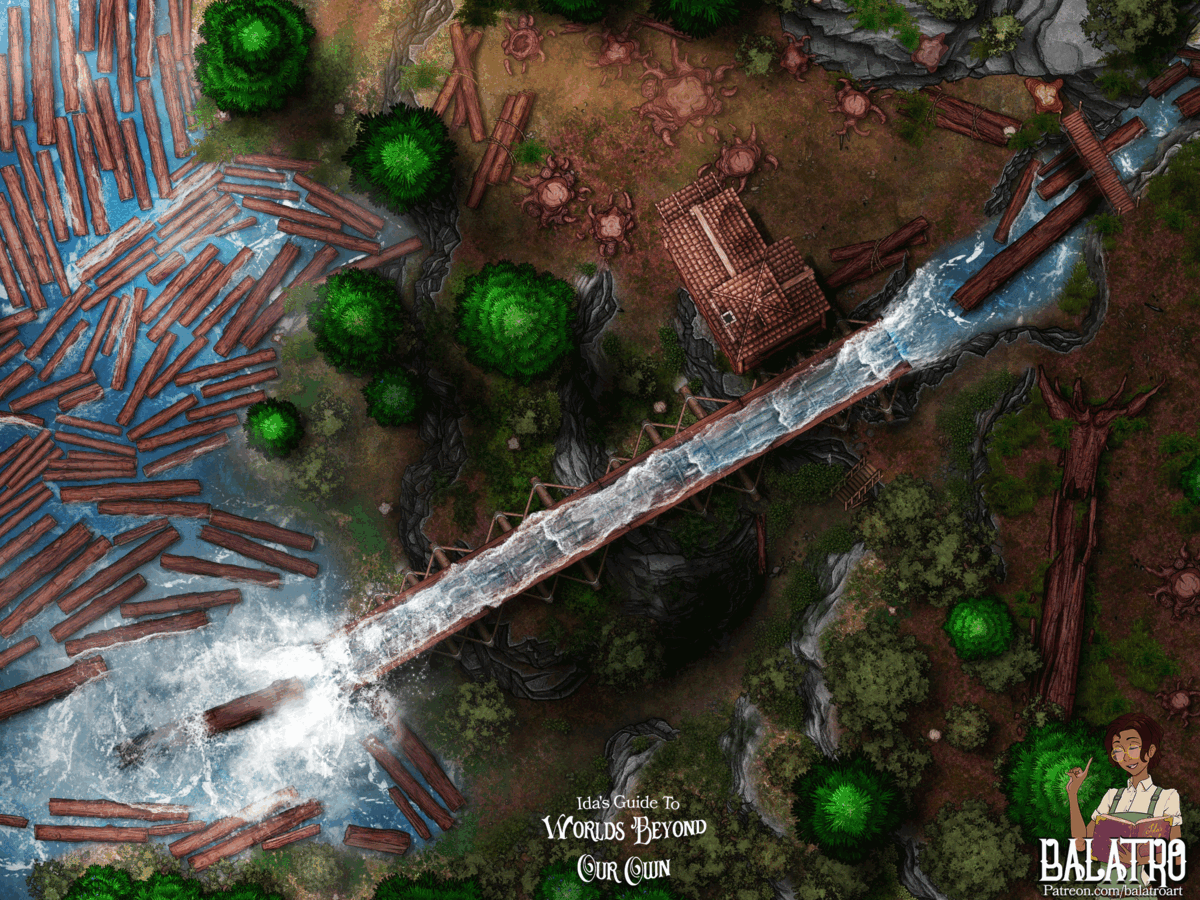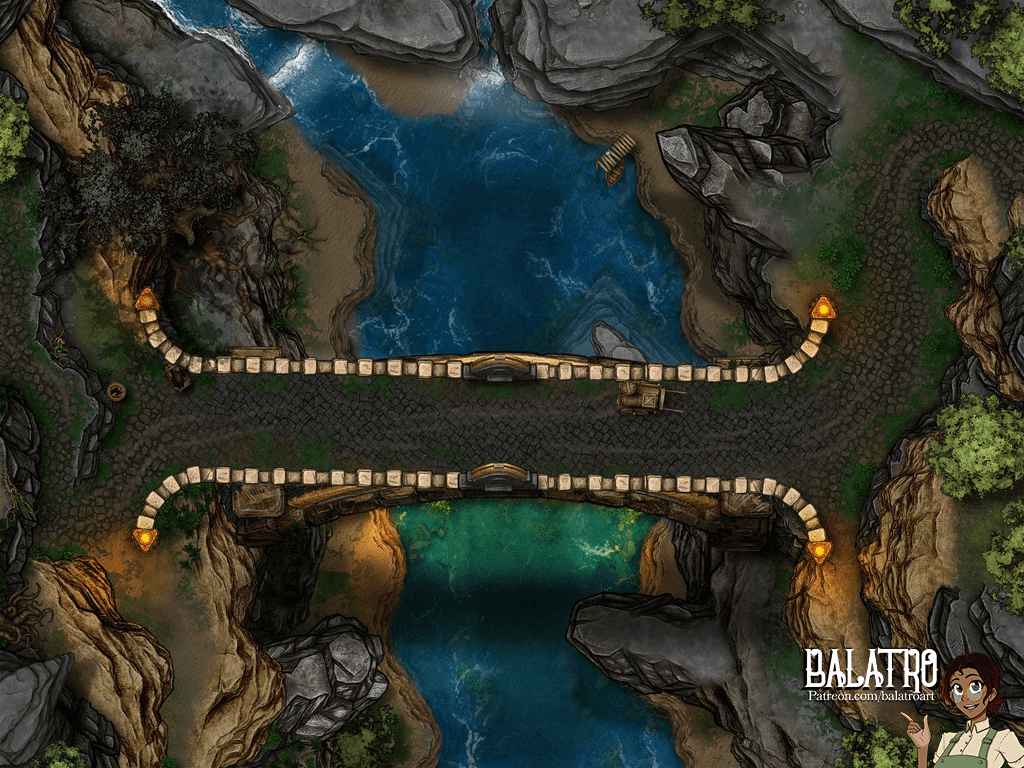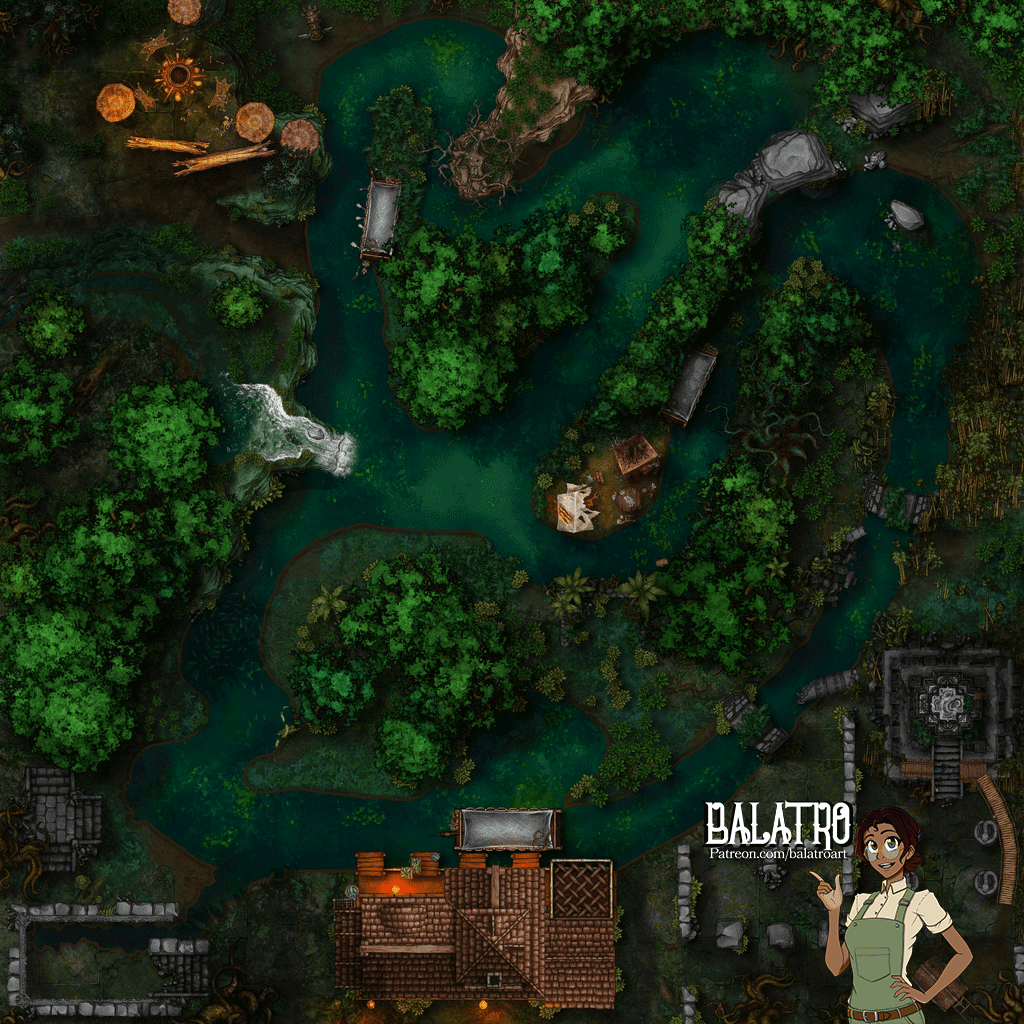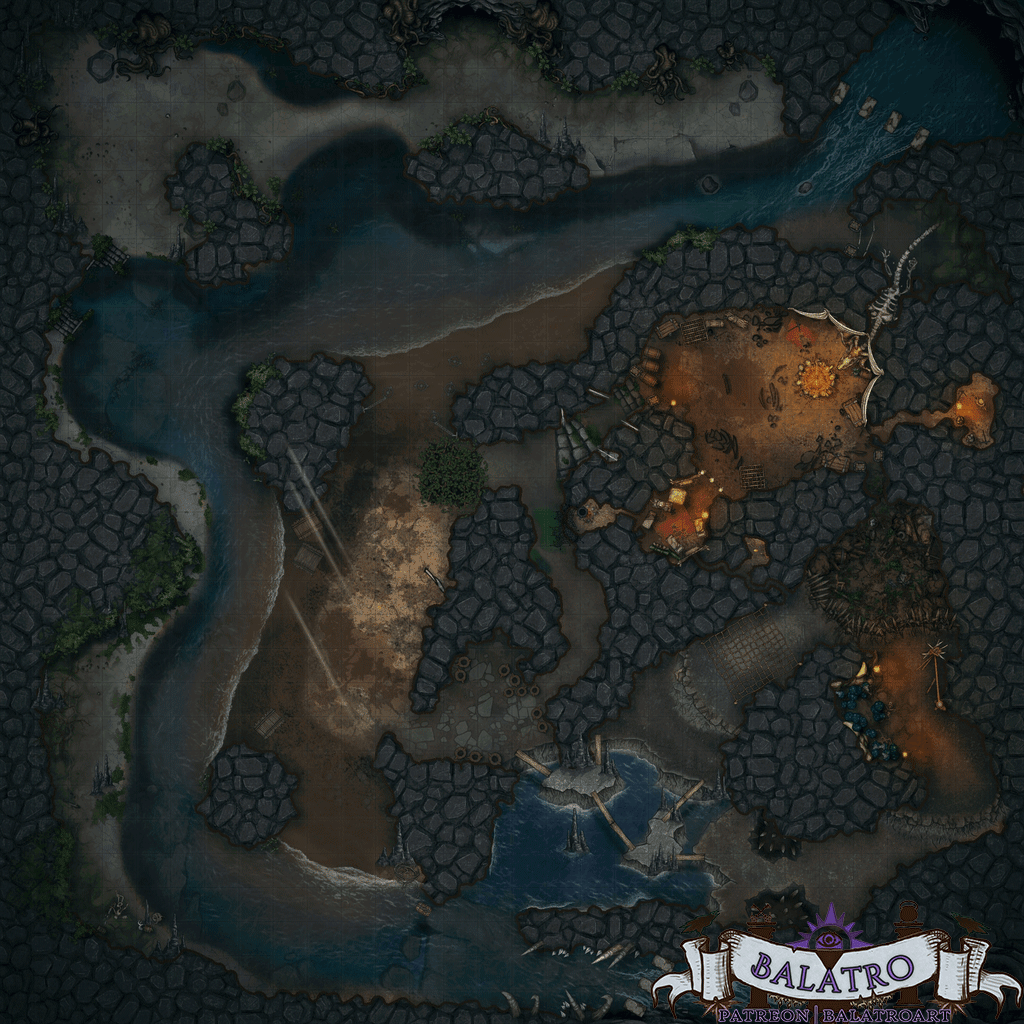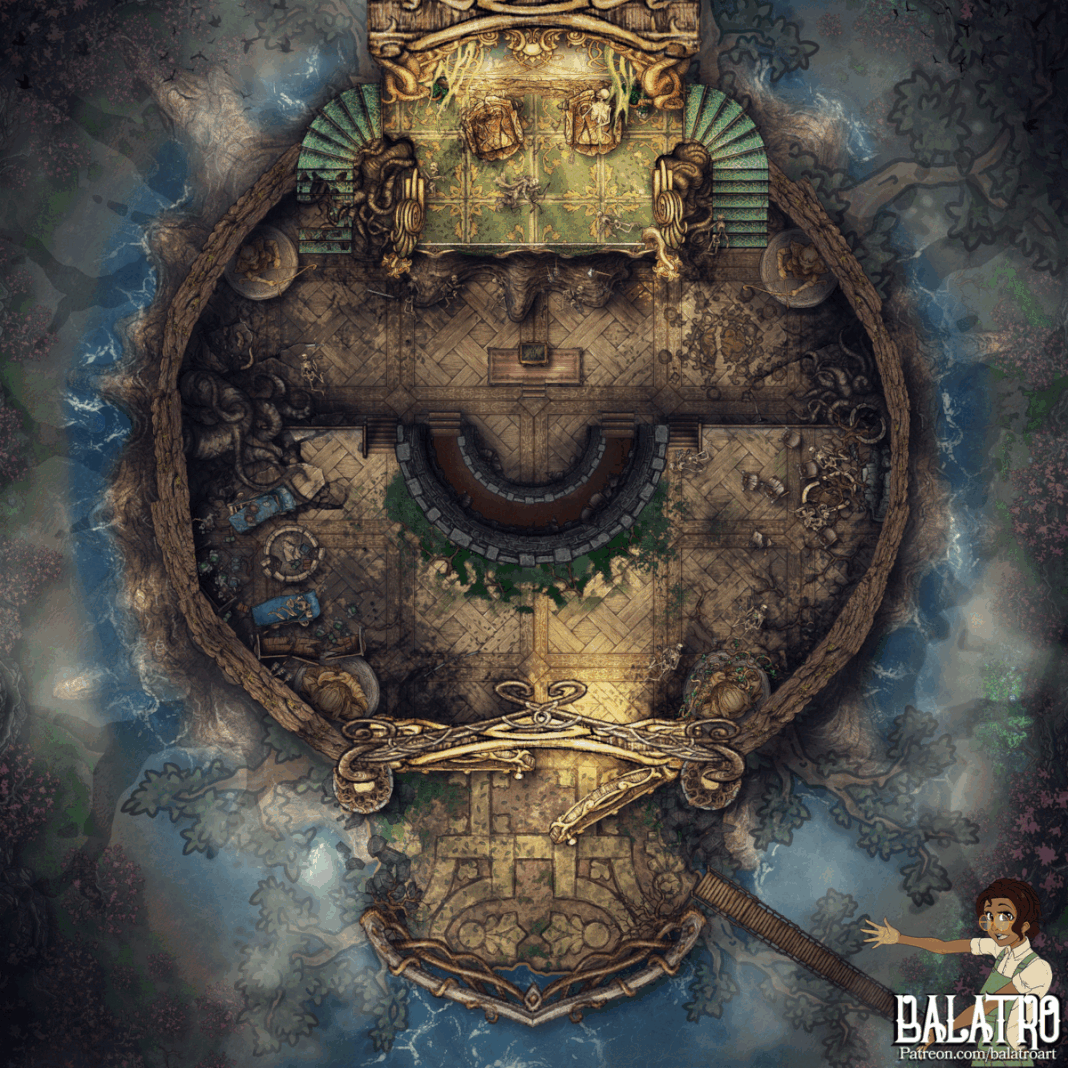
The Peaceful Riverlands
Thousand Tide Valley
Thousandtide is a peaceful land of winding rivers and misty woodlands, where each settlement—from the bustling boat-market of Shallow Harbor to the tranquil huts of Grassport—are built on or beside the calm meandering currents of a quiet river valley delta. The perils of the world outside the valley have nearly completely avoided this idyllic isolated place. The many Cultures that call Thousandtide home thrive on the water of the broken river streams with winding waterways and hidden wonders.
Battlemaps set in this location
Exile’s Door
North of the Thousandtide Valley lies a crack in the world. A vast pit with a stairway descending into the dark Sunless Sea, the most accessible passage of its kind. It earns its name from its use as a form of punishment in Dawnfire, enacted in place of execution. Criminals and vagrants convicted of capital offenses are given three choices: join the Crusade and fight in the war against Palavier, duel for their lives in the Agrakata arena, or face banishment through Exile's Door—never to return to the surface again.
Many choose the descent, risking the unknown for a chance at survival, as the other two options almost always lead to a swift and violent end.
Red River
Home to the plant humanoid root vegetable Firbolg, the Firebeets, the Red River where they live earns its name from the deep amber hue of its waters—stained by the tannins and pigments leached from them when they go to seed along its banks. The riverbed is thick with underwater plants, turning the current slow and earthy, its color a constant rust-red shimmer under the sun.
Lining the banks and nestled among the river rocks are small mud-and-thatch huts, held together with delicate red and white roots. The Firebeet Firbolg spend much of their time gathering mud and clay from the river, crafting intricate ceramics and pottery, which they sell to the rare travelers who pass through their vibrant community.
Cat Tail Crossing
Navigating Thousandtide can be a challenge for those without access to riverboats—or for those unwilling to swim through its slow, meandering currents. However, there are a few rare paths that allow travelers on foot to wade through shallow waters or leap between river stones.
The most well-known of these is Cat Tail Crossing, named for the thick marsh plants that grow in abundance across the northern shallows of Thousandtide. Few boats pass through this stretch, as the dense vegetation and muddy bottoms make it treacherous for navigation. Over the years, the crossing has gained a reputation as a smuggling route between the neighboring nations of Dawnfire and Ravenfall during their previous years of conflict.
Grassport
Nestled along the riverbank at the border of Ravenfall’s northern pasture lies the tiny town of Grassport, made up of no more than ten old stone buildings clustered near the edge of the Thousandtide River. A small clan of tortles spends their quiet days fishing and gathering river moss. It is an idyllic, peaceful place where, for generations, all but the greatest worldly strife has completely passed it by. Due to a stroke of extraordinary luck or a mysterious blessing, the locals cannot say—but some unseen force seems to watch over Grassport, preserving its gentle way of life.
Long River
The Long River forms the central artery of the Thousandtide Valley, running directly from one end of the valley to the other. Though it offers the most straightforward route, its steep rock walls and violent whitewater rapids make it one of the most dangerous rivers to travel in Thousandtide.
The worst portion, known as Tarmign’s Stryth, is a treacherous stretch of jagged stone where the river’s undercurrent becomes a roaring jet stream. The passage narrows to only six feet across, plunging into depths over 200 feet with broken, submerged caverns hidden in the darkness below. Considered impossible to navigate, Tarmign’s Stryth marks the deadliest waterway in all of Crudilex.
Wide River
The Wide River is a large, shallow expanse fed by a broad waterfall that spills just inches deep over a smooth, curved rock face. It is best known for its exceptionally active algae—threadlike strands that flow through the water like fur, with a slimy layer coating the surface. Below the falls, the water slows significantly, creating a calm habitat for a thriving community of Wog.
Halfway down the river lies a second, larger sloped waterfall. At the top of this rise stands a massive tree that has been hollowed out and converted into several buildings. Around this ancient tree, the Wog settlement of farmers raises giant insects and grubs. has grown, its heart rooted in the water and shaded by the canopy above.
Down Current
A tree-canopy-framed river-lake of extremely slow-moving water, Down Current is so shallow and clear that it appears as though you're floating among gravity-defying leaves and twigs, mere inches above the rocky ground. Fed by upstream waters, the lake widens to nearly a mile across, yet continues to meander forward at a lazy pace.
The cool, fresh water and abundant hiding places make Down Current a favored place for wildlife. Many species of beast migrate here during mating season, drawn by its calm and safety. Few people venture into the area—only the occasional hunter or boatman, dragging their riverboat ashore to portage it back upstream. For most, Down Current is considered the southernmost edge of Thousandtide, as the river’s flow into the delta and onward to the more dangerous territory beyond, Rayion.
Powrburgh Castle
The ancestral home of the Wog, Powrburgh Castle is a small, ivy-cloaked fortress bursting with flowers and home primarily to the very young, the very old, and the Wog royal family. Most Wog remember the castle fondly and dream of returning to it. But through Wog customs may only do so in pursuit of their personal Vow or upon its completion, when they may at last come home.
Though the castle is defensible, with high walls and a secure position, the Wog's cultural tradition of venturing out to better the world leaves few behind to care for the daily needs of those who remain within Powrburgh. Among the royal family, the eldest male is titled Prince—not King. This is because their ancient ancestor, Powrie—King of the Wog—is immortal. Driven mad by his own power, he vanished into the Wilder long ago and has never been seen since. His sons have since refused to crown a new king, believing the throne to be cursed. To them Wog their cultural legacy is one of tyranny and darkness—everything the Wog now stand against.
Underbridge
Underbridge is a hanging village built into the massive stone arches of the Sanroko II cross-national train bridge. Its buildings are crafted from fallen or removed bricks, hollowed into room-sized cavities within the structure itself, fronted with wooden facades and connected by a maze of ladders and hanging walkways.
It is a poor community of expats from all over Crudilex—many of whom were once stowaways aboard the train above. Ejected unceremoniously upon discovery, they banded together and built a community. Though densely packed and generally unsafe, life in Underbridge has broken down social barriers and forged a deep communal bond among its residents.
From time to time, individuals who display rare talent or promise are uplifted by the community. Artists, engineers, and musicians have, in the past, received communal support to seek education or scholarships they could not have pursued alone. One such individual, the musician Arabella Shaun, invented an instrument known as the currentsinger.
Currentsingers
A subaquatic musical instruments primarily played by Atlanteans. They harness river currents flowing over a tuned reed to produce echoing, resonant notes underwater. Underbridge itself houses a massive currentsinger at the town’s center—like a church bell—which dips below the waterline at hourly intervals. When it sounds, the deep, echoing note reverberates through the river and can be heard clearly even from above.
Little Atlantis
Little Atlantis is an Atlantean village with a high water well that descends deep into the ruins of Undrum Kal and the Sunless Sea. The village is home to the descendants of the Thryummian Atlanteans, one of Crudilex's oldest and most storied cultures. Their history is rich, and their lore is vast.
Despite its ancient roots, Little Atlantis is a peaceful and relaxed place. The people, basking in the safety and serenity of the Thousandtide Valley, spend most of their days fishing or floating down the river. They offer tours to visitors and serve as river guides, helping travelers navigate the many routes winding up and down the valley.
The town itself is built from pure white limestone, nestled along the banks and cliffs of the coastal ridges bordering Dawnfire. Many water features and structures are powered by the river's flow, and because its people are amphibious, the buildings are uniquely designed with both above and below-current features. Plumbing, refrigeration, and even farming are integrated into the flow of water. Tributaries and gutters wind through the town, giving it the feeling of being one giant, ornate fountain.
Shallow Harbor
Shallow Harbor is the closest thing to a city in all of Thousandtide. It is a vast lagoon with waters only Less than a foot or two deep, crisscrossed by walkways and bridges. Canoes and flat bottomed boats navigate the waters like a free-floating, living market that grows and shrinks throughout the day.
The harbor is the most diverse place in all of Crudilex. It serves as a transient hub for travelers and adventurers, a common stop for wholesalers and merchants, and an excellent place to stock up and prepare for long journeys. Few people actually live in the harbor itself; even the most reliable vendors come to trade rather than set up permanent shops. The population is highly seasonal, and during the long, rainy or humid months, Shallow Harbor becomes a near-empty ghost town.
Claybank Bog
The source of all the greatest rivers flowing into Thousandtide Valley, Claybank Bog is a vast, muddy expanse carved by water and time digging deep trenches into the red cliffs that surround it. The river here breaks apart across massive square slabs of clay, tangled with wild overgrown weeds, stretching upriver deep into the drylands north of Dawnfire and into the of the Plains of Avarice.
The sunbaked soil above is riddled with deep fissures that fill unpredictably with water and mud, triggering frequent and dangerous mudslides along the riverbanks. This natural volatility has made the region notoriously difficult to traverse, a factor that has long served the nearby cliffside kingdom of Abermore—perched safely above—as an unintentional but highly effective defense against sieges.
Riverlords Lurk
Home to the Riverlords of Thousandtide, this is the territory of a cruel Forgon clan of gator-like humanoids who are often trouble. The Riverlords, mostly young hooligans, rarely engage in anything more severe than brawls or petty theft. However, they frequently cause disruptions, especially when they spot tourist boats on the river. The Riverlords demand payment or bribes, tip boats over, lead travelers astray down wrong rivers, or break into cargo holds to steal food.
While the locals do not approve of the Riverlords' actions, they are rarely the targets of the harassment themselves. When a Riverlord does have a problem with someone from the local community, it is usually personal, rather than something involving the entire clan. Still, the Riverlords' love for trouble makes their antics a common occurrence.
Court of the Moss King
The Riverflower Firbolg, known as the Moss King, rules over the court, more cult leader than a noble. He has gathered the surviving members of the fallen Court of Summer—ghosts who perished when their Arch-Dryad, the personification of summer, was murdered. These spirits have since transformed into Ninoten, each embodying the ideals and ardent concepts of the lost season.
The Moss King believes that music belongs exclusively to the fey, and that mortals stole the gift of song from them. Those who sing within his realm call upon him, and he is summoned. If he disapproves of their singing, he sends the ghosts of summer to eat them. If he enjoys their song, he lures them to his lair and transforms them into fey.
The lands of the Moss King are more overgrown than anywhere else in Crudilex. Every inch of surface is covered by plants, endlessly competing for the faint light of the twin suns. Overhead, a choking canopy is hidden by a thick, ever-present mist. Underfoot, the ground is knee-deep in mud, with enormous, broken stone statues—once humanoid figures—now completely blanketed in moss, indistinguishable from their surroundings. Only their humanoid silhouettes hint at their original forms. The river leading into the Moss King’s realm slows as it spills into the muddy bog, appearing to come to a halt. Because no waters of Thousandtide can leave the Moss King’s domain without his permission.
Rattlerock
A massive boulder, trapped for hundreds—perhaps thousands—of years in a divot in a rocky riverbed. The boulder weighs an astounding 100 tons, yet a thin current, barely an inch deep, flows beneath it, causing the stone to slowly roll and rotate in place. Over time, the constant motion has worn the rock into a smooth polished sphere, grinding out a perfect bowl-shaped depression beneath it.
Though there is nothing inherently magical about this location, many of the non-arcane peoples of Crudilex hear tales of Rattlerock and refuse to believe it is not the work of some ancient Druid circle.
The Silent Chantry
Dawnfire is the ancestral home of all tieflings, yet among their infernal ranks, Abyssal tieflings born of void demons rather than infernal occasionally emerge. Unlike their infernal kin, Abyssal tieflings are marked by cool-toned skin, ranging from icy blues to muted greys, and unsettling black eyes devoid of sclera or iris. Without a defined cultural identity within Dawnfire’s hierarchy, many Abyssal tieflings struggle to find a place of belonging. Their differences in origin and appearance often set them apart, both socially and spiritually. For those seeking solace, many turn to a secluded refuge that welcomes them: The Silent Chantry, a shadowed temple dedicated to Monodono, the god of paranoia and evil.
Far removed from Dawnfire's bustling cities, the Silent Chantry provides sanctuary for those who embrace or are consumed by the void's enigmatic whispers. The temple is led by the mysterious Queen of Ravens. Her entourage—a cadre of anonymous, cloaked advisors and guardians—enforces the temple’s doctrines and guards its secrets. The chantry itself is a hauntingly beautiful structure, carved into the cliffs of a barren, windswept valley. Dark obsidian walls, and the spires reach skyward like jagged claws. Inside, the air is thick with silence, broken only by the soft murmurs of secret prayers and the fluttering of ravens that nest within the temple’s halls.
The Moongate
Across Crudilex lies a scattered network of ancient, mysterious circular gateways—dormant portals created long before recorded history and largely forgotten. These strange structures, known as Moongates, are often found in remote places, yet some stand near modern settlements, inspiring local legends and superstitions about their power and purpose.
One such Moongate lies at the southernmost edge of the known world, positioned in the no-man’s-land between the territories of two fiercely religious factions: the Silent Chantry and the marauding minotaur water barons of the Coalfrock Delta. Both groups have woven this enigmatic ruin into their mythology, claiming divine significance for the structure. Neither is willing to relinquish control, resulting in near-constant skirmishes over what is, at its core, a weathered circle of stone that hasn’t shown a flicker of power in millennia.
Coalfrock Delta
Originally constructed as a temporary outpost by the marauder Coalfrock minotaur tribe, the delta’s environment proved to be an ideal stronghold in their ongoing war against the Maze-hunting minotaurs of the greater culture. With numerous natural defenses along the edge of Rayion and access to a steady trade of fresh water from the well-protected delta, the Coalfrock tribe has risen to prominence as the water barons of the far southern territories. Though they continue to live in yurts and wagons, their outpost has been fortified so extensively that it now resembles a small city.



